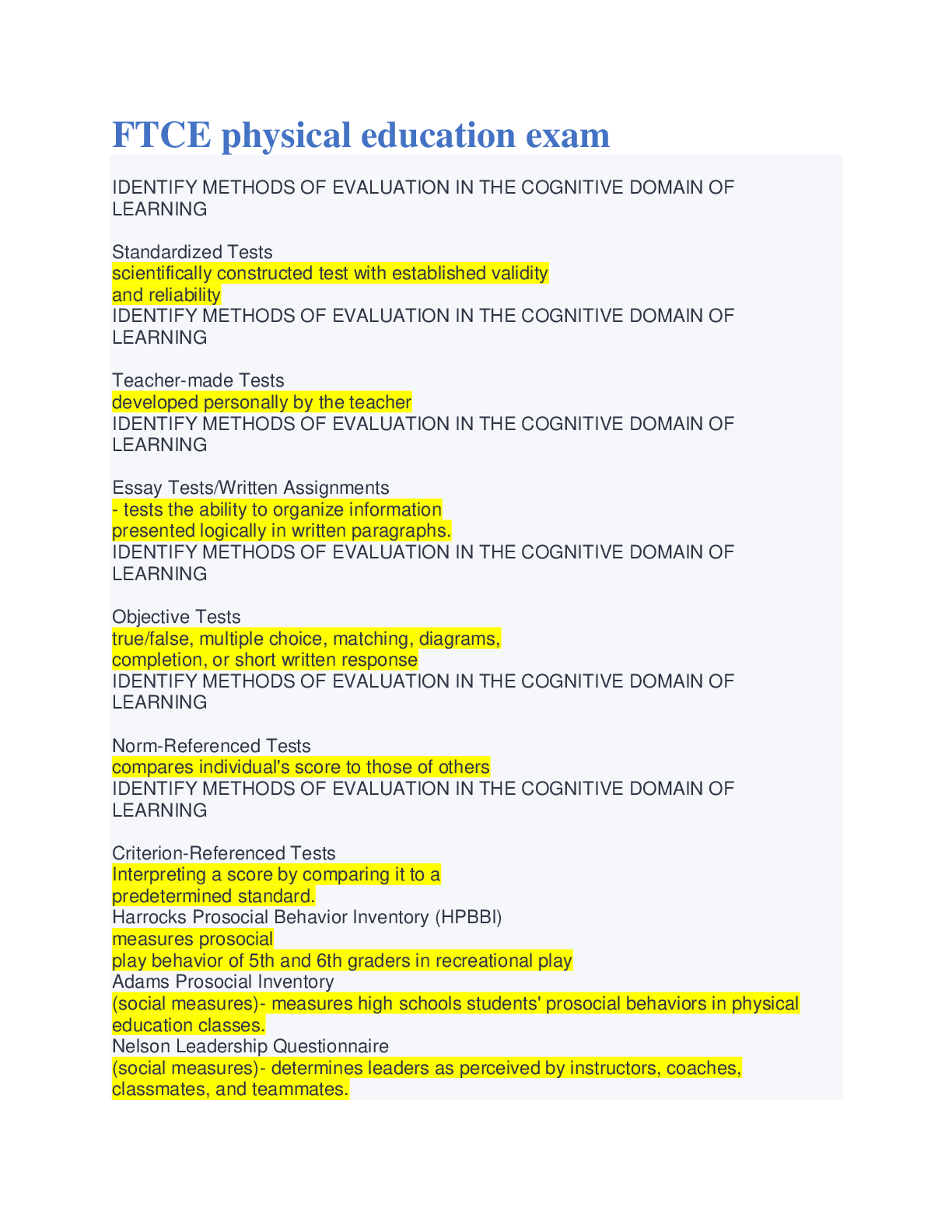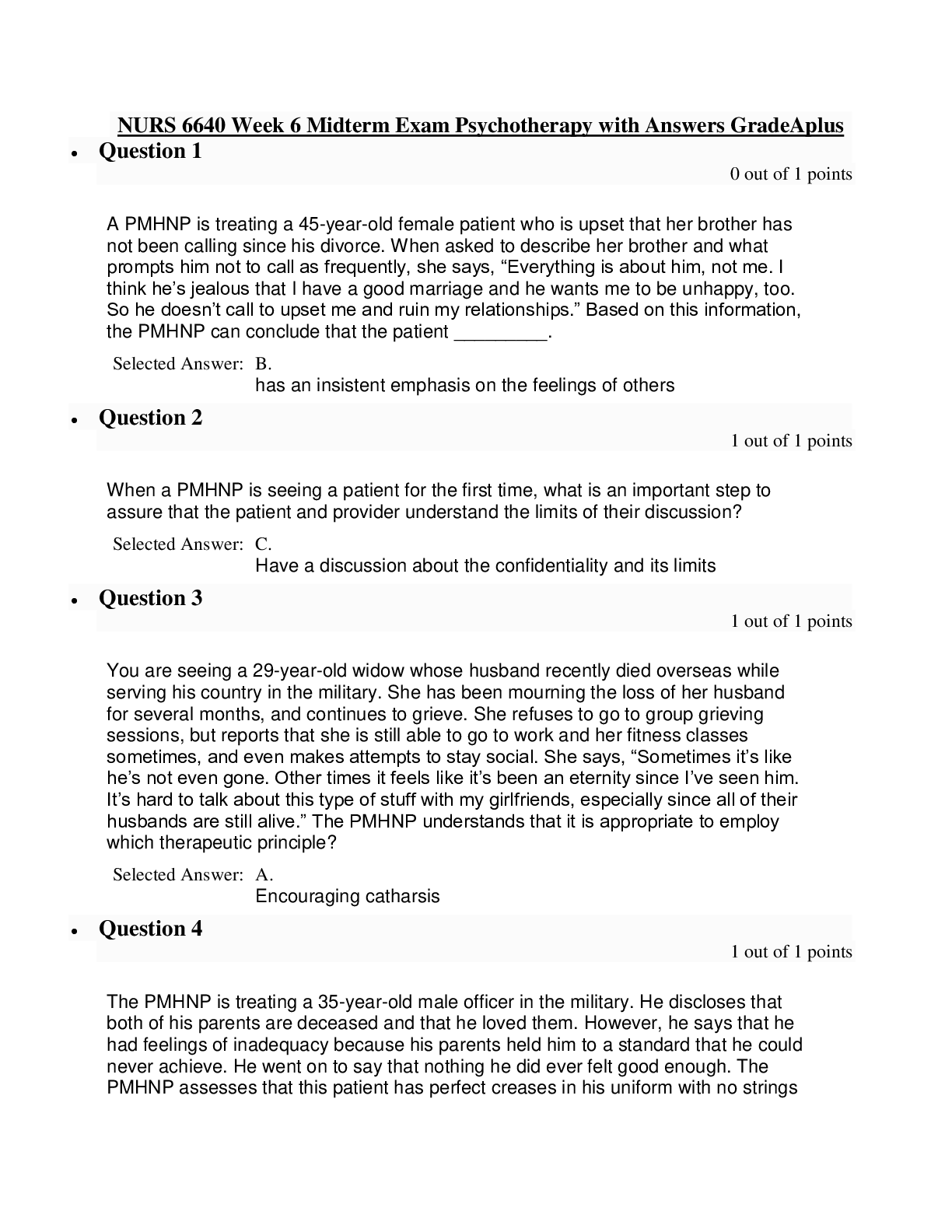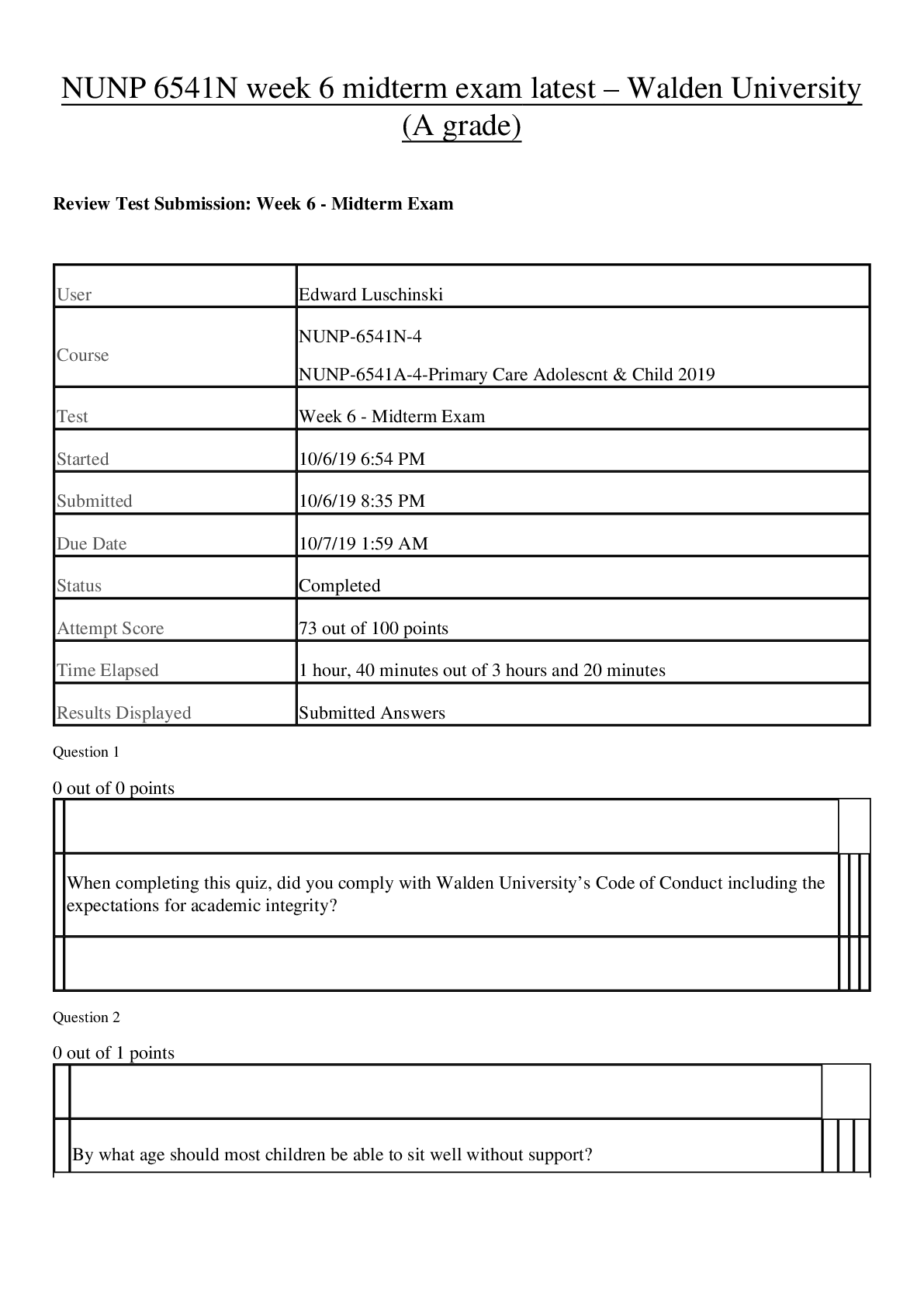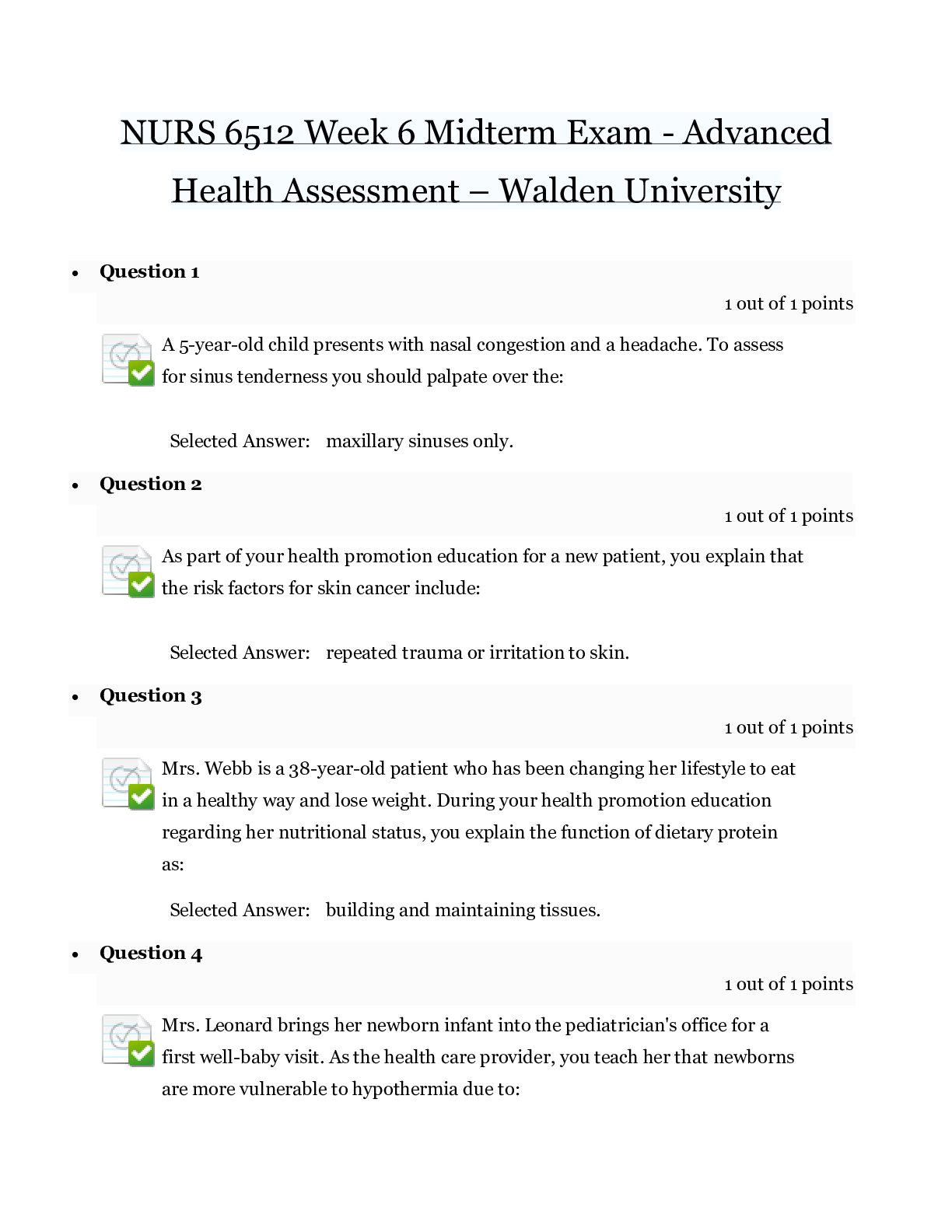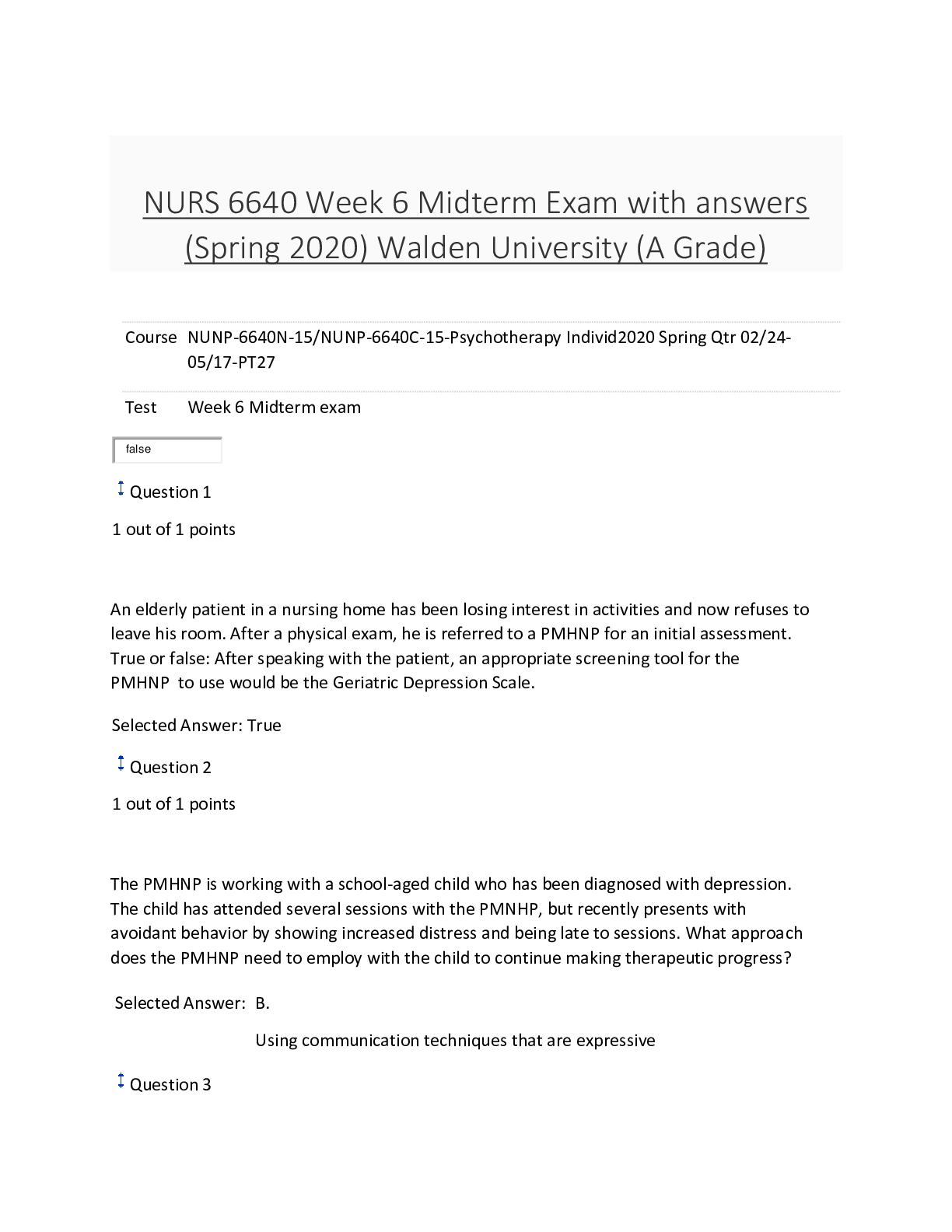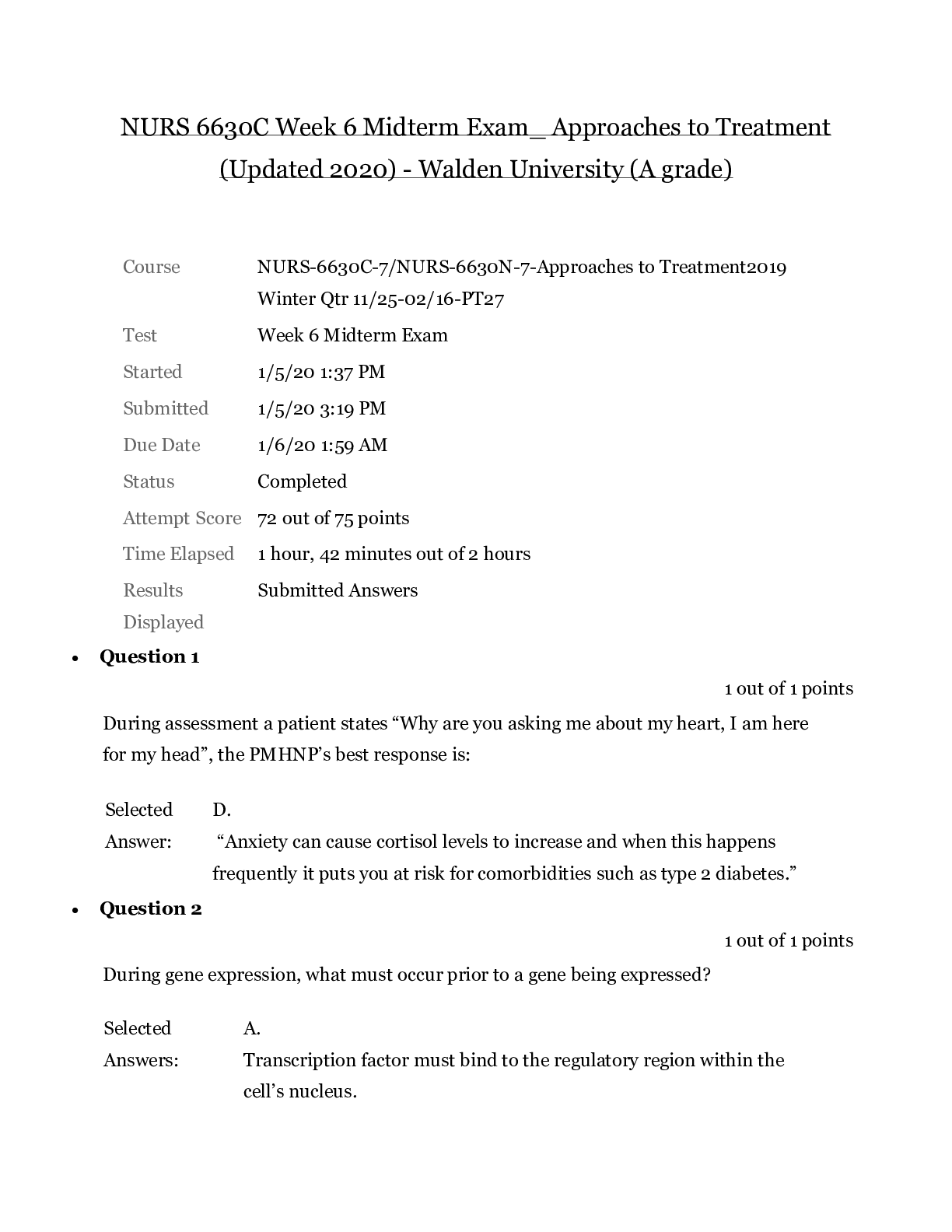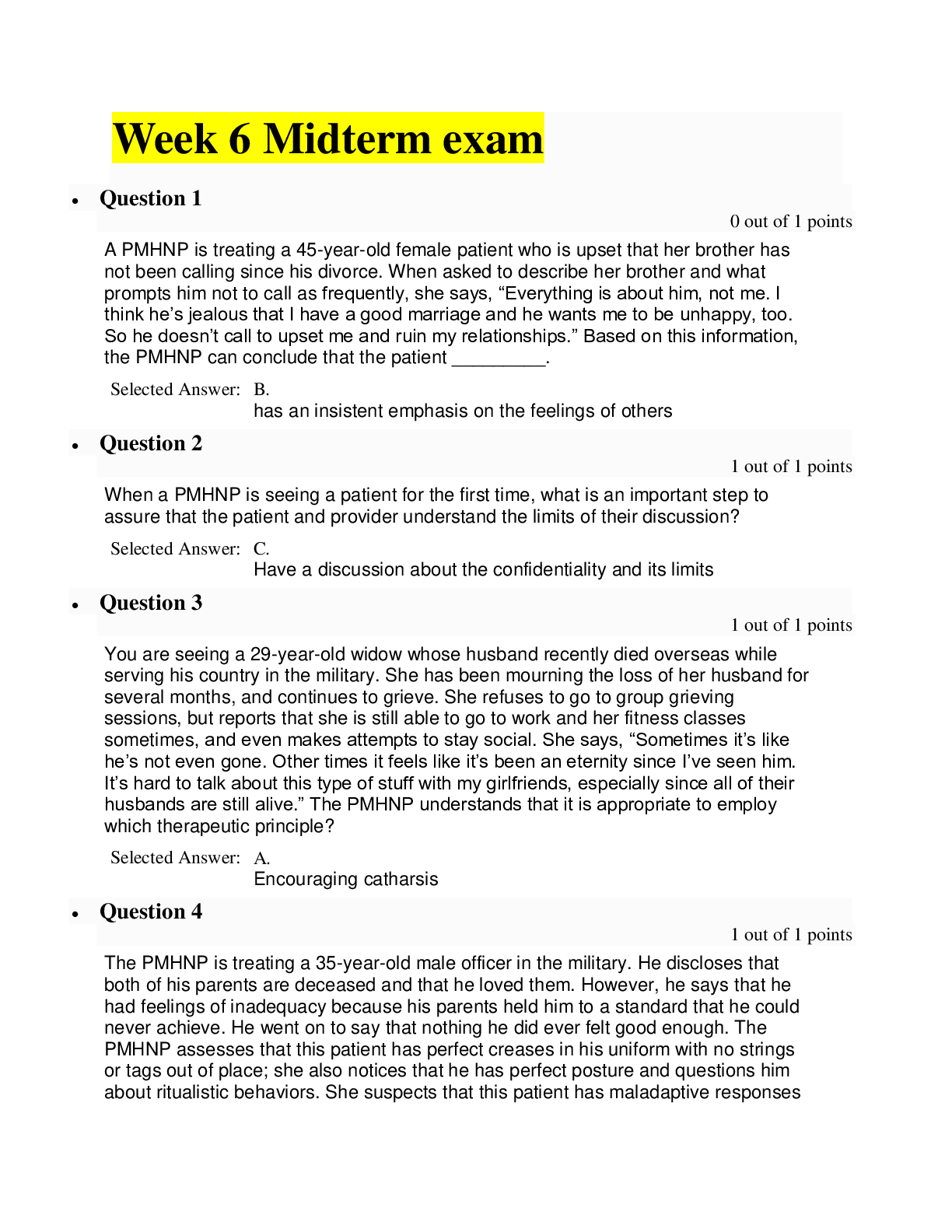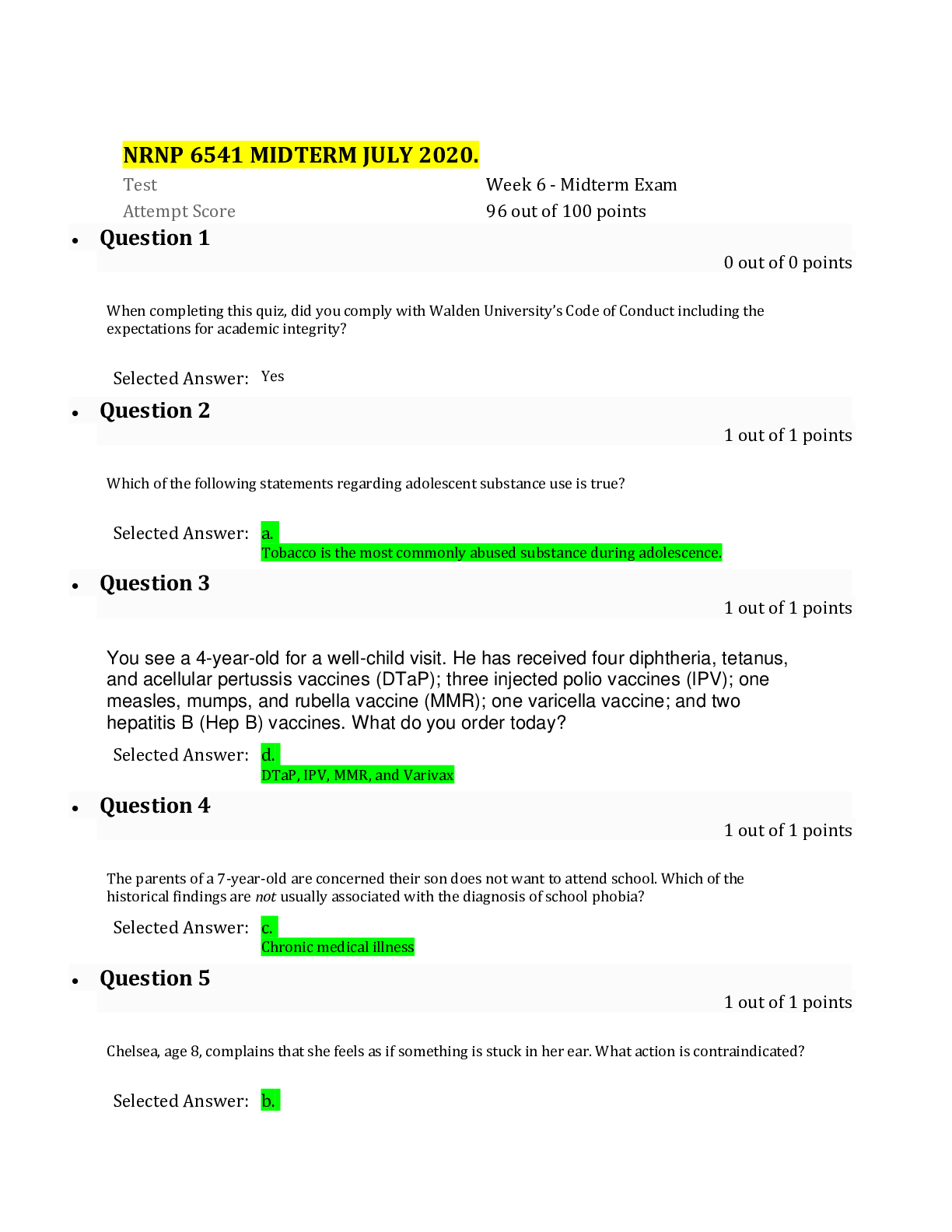Health Care > EXAM > NURS 6630-7 WEEK 6 MIDTERM EXAM WALDEN (All)
NURS 6630-7 WEEK 6 MIDTERM EXAM WALDEN
Document Content and Description Below
Review Test Submission: Week 6 Midterm Exam Course NURS-6630N-7,Approaches to Treatment.2018 Winter Qtr 11/26-02/17-PT27 Test Week 6 Midterm Exam Started 1/4/19 9:14 PM Submitted 1/4/19 9:59 PM ... Due Date 1/7/19 1:59 AM Status Completed Attempt Score 64 out of 75 points Time Elapsed 44 minutes out of 2 hours Results Displayed Submitted Answers Question 1 0 out of 1 points A noncompliant patient states, “Why do you want me to put this poison in my body?” Identify the best response made by the psychiatric-mental health nurse practitioner (PMHNP). Selected Answer: D. “Why do you believe that your medication is poison?” Question 2 0 out of 1 points Ms. Hill is currently being treated for schizophrenia but has stopped taking her medications due to some side effects she claims she was experiencing. She presents to the clinic today with worsening symptoms. She is experiencing anhedonia, agitation, attentional impairment, and affective blunting. Which one of the symptoms mentioned is considered a positive symptom of schizophrenia? Selected Answer: C. Attentional Impairment Question 3 1 out of 1 points Which statement about neurotransmitters and medications is true? NURS 6630-7 WEEK 6 MIDTERM EXAM WALDEN Selected Answer: B. Several psychiatric medications have been developed after discoveries of endogenous neurotransmitters and defining their function in the brain. Question 4 1 out of 1 points When an unstable patient asks why it is necessary to add medications to his current regimen, the PMHNP’s best response would be: Selected Answer: C. “Many psychiatric illnesses involve several dys-functioning neurotransmitter systems in the brain. Often, a single medication may only effect one or two of the dys-functioning systems. The addition of another medication can work with the current medication in stabilizing multiple neurotransmitter systems and help to alleviate your symptoms.” Question 5 1 out of 1 points During gene expression, what must occur prior to a gene being expressed? Selected Answers: A. Transcription factor must bind to the regulatory region within the cell’s nucleus. Question 6 1 out of 1 points While genes have potential to modify behavior, behavior can also modify genes. How do genes impact this process? Selected Answer: B. Changes made to proteins lead to changes in behavior. Question 7 1 out of 1 points Though medications have the ability to target neurotransmitter release into the synapse by the presynaptic neuron it is not always necessary. The PMHNP understands that this is because: Selected Answer: C. Neurotransmitters can spread by diffusion. Question 8 1 out of 1 points Why is the cytochrome P450 enzyme system of significance to the PMHNP? Selected Answer: B. The bioavailability of the medication after it passes through the stomach and liver can be altered. Question 9 1 out of 1 points It is important for the PMHNP to recognize differences in pharmacokinetics to safely prescribe and monitor medications. Which of the following statements does the competent PMHNP identify as true? Selected Answer: A. About 1 out of 5 Asians requires lower-than-normal doses of some antidepressants and antipsychotics. Question 10 1 out of 1 points As it relates to G-protein linked receptors, what does the PMHNP understand about medications that are used in practice? Selected Answer: A. Most medications that act on G-protein linked receptors have antagonistic traits. Question 11 1 out of 1 points The PMHNP is considering prescribing a 49-year-old male clozapine (Clozaril) to treat his schizophrenia and suicidal ideations. The PMHNP is aware that which factor may impact the dose needed to effectively treat his condition: Selected Answer: A. The patient smokes cigarettes. Question 12 0 out of 1 points A patient is diagnosed with bipolar disorder and is currently taking carbamazepine (Tegretol), aripiprazole (Abilify), and melatonin. The PMHNP has just written an order to discontinue the carbamazepine (Tegretol) for drug-induced thrombocytopenia. The PMHNP is aware that his next best action is to: Selected Answer: B. Write an order for a different mood stabilizer Question 13 1 out of 1 points A patient recently transferred following a suicide attempt has a history of schizophrenia, depression, and fibromyalgia. He is currently taking Amitriptyline (Elavil), Lisinopril, aspirin, and fluoxetine (Prozac). When assessing the psychiatric medications and the reason for admission, what would be the best course of action for the PMHNP with this client? Selected Answer: A. Review Amitriptyline (Elavil) level Question 14 0 out of 1 points A patient with schizophrenia is given an inverse agonist that acts on the receptor 5HT and neurotransmitter serotonin. What is the rationale for prescribing a medication such as this? Selected Answer: D. To help decrease the amount of serotonin and dopamine Question 15 1 out of 1 points The PMHNP is caring for four patients. Which patient statement indicates that benzodiazepines would be beneficial? Selected Answer: D. “I feel nervous to go outside and be in large crowds.” Question 16 1 out of 1 points Ms. Harlow is a 42-year-old patient who is prescribed a drug that acts on ionotropic receptors. She is curious about the effects of the drug and how it will act on her symptoms. Which statement made by the PMHNP demonstrates proper understanding of Ms. Harlow’s prescription? Selected Answer: A. “The drug will have an almost immediate effect.” Question 17 1 out of 1 points A patient is seeking pharmacological treatment for smoking cessation. Which drug class does the PMHNP prescribe to the patient? Selected Answer: D. Varenicline (Chantix) Question 18 1 out of 1 points The PMHNP is caring for a new patient who has been transferred from another office. When meeting with the new patient, the patient reports, “I feel like I am improving with the stabilizers.” The PMHNP immediately recognizes that the patient is describing which kind of drug? Selected Answer: C. Partial agonists Question 19 1 out of 1 points A patient presents with frequent episodes of mania. Which statement describes an appropriate treatment approach for this patient? Selected Answer: B. “The patient could benefit from an anticonvulsant.” Question 20 1 out of 1 points What characteristics do the nicotinic, cholinergic, serotonin 3, and glycine receptors all have in common? Selected Answer: A. Ligand-gated ion channels with a pentameric structure Question 21 1 out of 1 points Which statement made by the patient suggests the patient will need to be treated with antipsychotics that target paranoid psychosis? Selected Answer: B. “I have to talk to the President because I’m the only one who can help him.” Question 22 1 out of 1 points Mr. McCullin is 64 years old with Parkinson’s disease. The PMHNP caring for Mr. McCullin wants to start him on a dopamine agonist to help manage and treat his condition. The PHMNP selects this agent because of which action it has on patients like Mr. McCullin? Selected Answer: D. D2 receptors are the primary binding site for dopamine agonists. Question 23 1 out of 1 points Mrs. Trevor is a 44-year-old patient who does not have a diagnosis of schizophrenia but occasionally reports symptoms of psychosis, followed by severe fatigue. Mrs. Trevor inquires about the use of amphetamines to help with her energy levels. Which response made by the PMHNP is most appropriate? Selected Answer: C. “Amphetamines can cause hallucinations, so I would advise against this type of prescription.” Question 24 1 out of 1 points The PMHNP is caring for a patient with schizophrenia and is considering a variety of treatment approaches. The PHMNP selects a viable treatment that is consistent with the “dopamine hypothesis of schizophrenia.” What action does the PMHNP anticipate this treatment having on the patient? Selected Answer: B. Hyperactivity in the mesolimbic dopamine pathway mediates the positive symptoms of schizophrenia. Question 25 0 out of 1 points A patient is diagnosed with schizophrenia. What increases the patient’s potential to mediate the cognitive symptoms of the disease? Selected Answer: B. Achieving overactivity of the mesocorticol proj [Show More]
Last updated: 2 years ago
Preview 1 out of 15 pages

Buy this document to get the full access instantly
Instant Download Access after purchase
Buy NowInstant download
We Accept:

Reviews( 0 )
$20.00
Can't find what you want? Try our AI powered Search
Document information
Connected school, study & course
About the document
Uploaded On
Aug 17, 2022
Number of pages
15
Written in
Additional information
This document has been written for:
Uploaded
Aug 17, 2022
Downloads
0
Views
89












